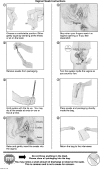Vaginal self-swab specimen collection in a home-based survey of older women: methods and applications
- PMID: 19204072
- PMCID: PMC2763518
- DOI: 10.1093/geronb/gbn021
Vaginal self-swab specimen collection in a home-based survey of older women: methods and applications
Abstract
Objectives: To describe the methods used for, cooperation with, assays conducted on, and applications of vaginal specimens collected by older women in their homes.
Methods: Community-residing women (N = 1,550), ages 57-85 years, participated in a nationally representative probability survey. Vaginal self-swab specimen collection and in-home interviews were conducted between 2005 and 2006. Specimens were analyzed for bacterial vaginosis (BV), vaginal candidiasis (VC), high-risk human papillomavirus (HR-HPV), and cytological characteristics. Field methods, consent procedures, the swab protocol, laboratory procedures, and results reporting are described.
Results: One thousand twenty-eight respondents (67.5% weighted) agreed to provide a vaginal specimen; 99.1% were successful. The specimen adequacy rates were BV and VC, 94.1%; HR-HPV, 99.7%; and cytology, 85.5%. The most common recorded reason for nonparticipation was a physical or health problem (38% of nonresponders). Responders were significantly more likely than nonresponders to be younger and more educated, and were more likely to report a recent pelvic examination, menopausal hormone use, and recent sexual activity.
Discussion: Collection of vaginal self-swab specimens from older women in a population-based study is feasible and provides novel data on microenvironmental characteristics of the female genital tract relevant to analyses of gynecologic health, sexual activity and problems, and immune and inflammatory function.
Figures





Similar articles
-
Evaluation of reliability of self-collected vaginal swabs over physician-collected samples for diagnosis of bacterial vaginosis, candidiasis and trichomoniasis, in a resource-limited setting: a cross-sectional study in India.BMJ Open. 2019 Aug 27;9(8):e025013. doi: 10.1136/bmjopen-2018-025013. BMJ Open. 2019. PMID: 31462459 Free PMC article.
-
Self-taken vaginal swabs versus clinician-taken for detection of candida and bacterial vaginosis: a case-control study in primary care.Br J Gen Pract. 2017 Dec;67(665):e824-e829. doi: 10.3399/bjgp17X693629. Br J Gen Pract. 2017. PMID: 29158246 Free PMC article.
-
Prevalence of bacterial vaginosis and Candida among postmenopausal women in the United States.J Gerontol B Psychol Sci Soc Sci. 2014 Nov;69 Suppl 2(Suppl 2):S205-14. doi: 10.1093/geronb/gbu105. J Gerontol B Psychol Sci Soc Sci. 2014. PMID: 25360022 Free PMC article.
-
Diagnostic accuracy of self collected vaginal specimens for human papillomavirus compared to clinician collected human papillomavirus specimens: a meta-analysis.Sex Transm Infect. 2005 Jun;81(3):207-12. doi: 10.1136/sti.2004.011858. Sex Transm Infect. 2005. PMID: 15923286 Free PMC article.
-
Comparing Clinician-Collected and Self-Collected Tests for Detecting High-Risk HPV Infection among Female-to-Male Transgender Adults [Internet].Washington (DC): Patient-Centered Outcomes Research Institute (PCORI); 2018 Sep. Washington (DC): Patient-Centered Outcomes Research Institute (PCORI); 2018 Sep. PMID: 37844157 Free Books & Documents. Review.
Cited by
-
Acceptability of testing for anorectal sexually transmitted infections and self-collected anal swabs in female sex workers, men who have sex with men and transgender women in Papua New Guinea.BMC Public Health. 2018 Jun 20;18(1):776. doi: 10.1186/s12889-018-5684-2. BMC Public Health. 2018. PMID: 29925348 Free PMC article.
-
A pilot randomized trial to prevent sexual dysfunction in postmenopausal breast cancer survivors starting adjuvant aromatase inhibitor therapy.J Cancer Surviv. 2017 Aug;11(4):477-485. doi: 10.1007/s11764-017-0606-3. Epub 2017 Feb 22. J Cancer Surviv. 2017. PMID: 28229275 Clinical Trial.
-
Acceptability and usability of self-collected sampling for HPV testing among African-American women living in the Mississippi Delta.Womens Health Issues. 2013 Mar-Apr;23(2):e123-30. doi: 10.1016/j.whi.2012.12.003. Epub 2013 Feb 12. Womens Health Issues. 2013. PMID: 23410619 Free PMC article.
-
Families, social life, and well-being at older ages.Demography. 2010;47 Suppl(Suppl 1):S87-109. doi: 10.1353/dem.2010.0009. Demography. 2010. PMID: 21302422 Free PMC article.
-
Home-based self-collection of biological samples, including vaginal swabs: a mixed methods study for Britain's fourth National Survey of Sexual Attitudes and Lifestyles (Natsal-4).Sex Transm Infect. 2025 May 19;101(4):252-255. doi: 10.1136/sextrans-2024-056386. Sex Transm Infect. 2025. PMID: 39798995 Free PMC article.
References
-
- Allsworth JE, Peipert JF. Prevalence of bacterial vaginosis—2001–2004 National Health and Nutrition Examination Survey data. Obstetrics & Gynecology. 2007;109:114–120. - PubMed
-
- Baseman JG, Koutsky LA. The epidemiology of human papillomavirus infections. Journal of Clinical Virology. 2005;32:S16–S24. - PubMed
-
- Bibbo M. Comprehensive cytopathology. 2nd ed. Philadelphia: Saunders; 1997.
-
- Campanelli P, O’Muircheartaigh C. Interviewers, interviewer continuity, and panel survey nonresponse. Quality & Quantity. 1999;33:59–76.
Publication types
MeSH terms
Grants and funding
LinkOut - more resources
Full Text Sources
Medical

